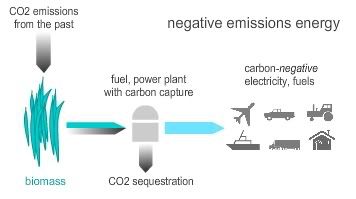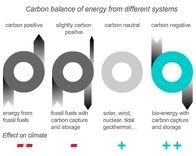The strange world of carbon-negative bioenergy: the more you drive your car, the more you tackle climate change

The companies make another amazing claim: they say the EU's widely hailed efforts to reduce carbon emissions from cars from the present 160 grams per kilometer to 120 g/km are complete nonsense - an incredibly mediocre proposal. Because with their car and energy, you will be reducing carbon emissions by -30 grams per kilometer. Yes, minus 30 grams. Not 120, not zero, but -30.
Finally, they say leading scientists have calculated that when all of us were to do the effort of driving this car with carbon-negative energy and if we replace all other fossil fuels (coal, natural gas), with negative emissions energy, we can bring atmospheric CO2 levels back to pre-industrial levels by mid-century and thus prevent the destruction of life on the planet by global warming.
After hearing the news from the companies, climate campaigners began protesting at wind, solar and nuclear power plants which supply carbon-neutral electricity used by supposedly climate saving electric cars which had begun appearing on the market. Why are they protesting? They explain their anger:
We protest against the use of these old world renewables because they are carbon-neutral. These technologies are not ethical. People should stop using them because there are carbon-negative alternatives available that take historic emissons away. We cannot use carbon-neutral technologies because the window to fight climate change has long closed. All money must now be invested into negative emissions technologies, not in old-school solar and wind, let alone in dangerous nuclear. All those who refuse to invest in negative emissions energy are commiting a crime against the planet! - climate campaigners in 2015Welcome to the bizarre, mildly surreal world of carbon-negative bioenergy. The public at large is not familiar with the concept yet. Anyone who claims that there will be a time when the more we drive our cars, the more we mitigate climate change, will be called outright crazy. Moreover, if the claim is correct it would mean the end of the climate change 'industry' and of global warming panic. This is clearly a threat to those who have an interest in keeping this panic alive without offering practical solutions. It is also a threat to the nuclear lobby and to some renewables lobbies who are offering mere 'carbon-neutral' energy. Understandably, for this reason, the concept is being ignored by these sectors, by governments and by mainstream media. The idea is too revolutionary.
However, it is only a matter of time before the amazing future of negative emissions energy becomes a reality. When people become aware of the implications of the concept, they will demand its immediate implementation.
But how does this concept work exactly? It is easy to understand:
 energy :: sustainability :: biomass :: bioenergy :: energy crops :: carbon balance :: carbon capture and storage :: negative emissons :: climate change :: global warming :: future ::
energy :: sustainability :: biomass :: bioenergy :: energy crops :: carbon balance :: carbon capture and storage :: negative emissons :: climate change :: global warming :: future ::  When we grow biomass (trees, grasses), CO2 is taken out of the atmosphere. The plants use it as a fuel for their own growth. When these energy crops are then burned in a power plant or burned as biofuels in a combustion engine, CO2 is released back into the atmosphere. This is a 'carbon-neutral' cycle: you do not add new carbon dioxide to the atmosphere. But now comes the trick. When you capture the CO2 from the biomass power plant or the biofuel facility before it enters the atmosphere, and then sequester the greenhouse gas in geological formations such as depleted oil & gas fields, or saline acquifers, you obtain carbon-negative fuels and energy. Negative emissions energy can only be obtained from biomass (schematic, click to enlarge).
When we grow biomass (trees, grasses), CO2 is taken out of the atmosphere. The plants use it as a fuel for their own growth. When these energy crops are then burned in a power plant or burned as biofuels in a combustion engine, CO2 is released back into the atmosphere. This is a 'carbon-neutral' cycle: you do not add new carbon dioxide to the atmosphere. But now comes the trick. When you capture the CO2 from the biomass power plant or the biofuel facility before it enters the atmosphere, and then sequester the greenhouse gas in geological formations such as depleted oil & gas fields, or saline acquifers, you obtain carbon-negative fuels and energy. Negative emissions energy can only be obtained from biomass (schematic, click to enlarge).In this concept, called 'bio-energy with carbon storage' (BECS), energy crops act like 'carbon capturing' machines. BECS systems can result in negative emissions electricity (which can power future electric vehicles), or in negative emissions liquid and gaseous fuels (Fischer-Tropsch fuels, biohydrogen) for use in combustion engines and fuel cells.
Now each time you were to drive a car that taps such carbon-negative energy, something very strange happens. In the old world (today's world), you would have taken pride in "reducing" your carbon footprint. You thought you were doing a great thing by buying a hybrid that results in fewer emissions, but still adds greenhouse gas emissions. In the new world, you will only be content when you have taken emissions from the past - from the year 2000, from 1990, from 1980 - out of the atmosphere.
Where will the biomass for BECS come from? From any source: from grasses, from wood, from new energy crops that store more carbon-dioxide as they grow. The explicitly sustainable potential for biomass production is very high: IEA Bioenergy scientists have estimated it to be over 1300 Exajoules by 2050.
If we were to exploit this potential in a rational manner, we will be entering an entirely new, strange energy age, that of negative emissions. All the technologies and market mechanisms needed to make this happen are gradually coming together: efficient carbon capture techniques; highly productive non-food energy crops that require low amounts of inputs, yield high amounts of biomass and take more CO2 out of the atmosphere than older varieties; a carbon market; and a growing awareness of the fact that our time to mitigate climate change is up.
In practise, BECS can be coupled to 'intermittent' renewables like solar and wind power. Carbon-negative biomass power plants will deliver base load and peak load power to solar and wind farms. Nobody could any longer claim that wind power or solar actually increase the use of coal needed to deliver the base-load. A robust hybrid energy model will emerge - entirely clean, with a negative carbon balance.
Moreover, BECS allows for decentralised production: by identifying carbon storage sites that are located far away from populations, and by growing biomass nearby, liquid carbon-negative fuels can be produced and then shipped to markets. By decentralising the projects, the risk for CO2 leaks that would affect populations, is eliminated.
Another advantage of BECS over carbon capture from fossil fuels: leakage of sequestered CO2 originating from biomass would not be catastrophic, because, contrary to CO2 escaping from fossil fuel carbon storage projects, the CO2 that would enter the atmosphere does not add to the original CO2 levels.
Everyone who takes climate change seriously can only encourage the transition towards carbon-negative bioenergy. It allows us to drive our cars, buses and trucks guilt-free. It allows us to travel on airplanes guilt-free. It allows us to ship goods in a guilt free manner. In fact, it puts us before an entirely new, strange logic: the more we drive our cars with carbon-negative bioenergy, the more we tackle climate change; the more we prevent the extinction of thousands of species; the more we prevent the potentially catastrophic effects of global warming.
But we are aware of the fact that in order to make this amazing future a reality, a lot of courage and work is needed from all stakeholders: governments, energy companies, farmers and poor rural communities in the developing world, environmentalists and civil society, consumers in the West and the best geologists, plant biologists and engineers of this world.
Biopact is currently writing an introductory leaflet explaining the revolutionary BECS-concept and its bright green future more in depth. Anyone who will read it will be, we think, amazed at what it really implies. The concept deserves more attention. It is our best shot at preventing catastrophic climate change.
 --------------
--------------
 Austrian bioenergy group Cycleenergy acquired controlling interest in Greenpower Projektentwicklungs GmbH, expanding its biomass operational portfolio by 16 MW to a total of 22 MW. In the transaction Cycleenergy took over 51% of the company and thereby formed a joint venture with Porr Infrastruktur GmbH, a subsidiary of Austrian construction company Porr AG. Greenpower operates two wood chip CHP facilities in Upper and Lower Austria, each with an electric capacity of 2 MW. The plants have been in operation since the middle of last year and consume more than 30,000 tonnes of wood chips and are expected to generate over €5 million in additional revenue.
Austrian bioenergy group Cycleenergy acquired controlling interest in Greenpower Projektentwicklungs GmbH, expanding its biomass operational portfolio by 16 MW to a total of 22 MW. In the transaction Cycleenergy took over 51% of the company and thereby formed a joint venture with Porr Infrastruktur GmbH, a subsidiary of Austrian construction company Porr AG. Greenpower operates two wood chip CHP facilities in Upper and Lower Austria, each with an electric capacity of 2 MW. The plants have been in operation since the middle of last year and consume more than 30,000 tonnes of wood chips and are expected to generate over €5 million in additional revenue.








3 Comments:
The total biomass of the Earth captures around 2000 exajoules of the sun's energy each year, so I'd say it's a bit optimistic to write that we could get 1300 exajoules of usable energy out of biomass. That would mean converting about 65% of the earth's new biomass each year into fuel, with a process that is 100% efficient. Not exactly realistic.
Furthermore, since much of that biomass is not new organisms, but rather additional growth of existing organisms, meeting that goal would require harvesting a substantial amount of long-term biomass each year and then replanting. Ecologically speaking, what that would mean over time is cutting down forests and replacing them with crop fields.
Well, there are some projections by the IEA Bioenergy Task 40 showing that there's a theoretical maximum potential of 4000 Exajoules of the world's terrestrial biomass.
In a high efficiency scenario we can capture a maximum of 1300Ej of that, by 2050, without deforestation and after satisfying all food, fiber and fodder needs of rapidly growing populations.
These projections are well known and have been discussed here widely.
See this article (and the sources in the comment section):
IEA Bioenergy
But it's true that this is a highly optimistic scenario.
The more realistic scenarios are between 200 and 400 Ej (see the same article).
We were just trying to make a theoretical point, that in principle, you could replace a large chunk of our fossil energy by carbon negative bioenergy.
Just to add to the discussion on the global biomass potential: Berndes et al (Biomass and Bioenergy 25 (2003)) have reviewed a series of estimates and the potential is somewhere between 100 EJ/yr and 400 EJ/yr.
Post a Comment
Links to this post:
Create a Link
<< Home